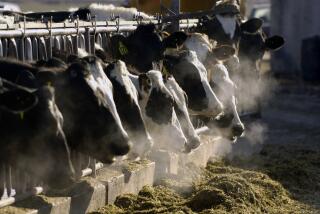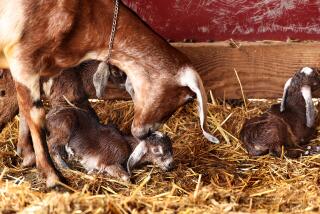Today’s Vet Heals Both Flock, Farmers
- Share via
STORRS, Conn. — Lucy is nursing and cleaning up her baby, Lil, born less than an hour before her visitors arrive. Vanessa is bleeding from a cut in her ear. Ginger and Gina are having a late breakfast.
“Moo,” they greet their callers.
The visitors are not cowed. They are a professor and two fourth-year students from Tufts University School of Veterinary Medicine, and they are here to test nearly 100 cows at the University of Connecticut dairy farms for pregnancy.
They will not use home pregnancy tests or ultrasound. Instead, they will reach deep into the cow and check to see if her uterus is enlarged.
Not that they are without modern techniques and technology. It’s just that it saves time and money to do it the old-fashioned way, and time and money are much on the minds of these vets.
Today’s veterinarians use syringes and scalpels and ultrasound machines, but they also use calculators. They are reaching beyond emergency and sick-cattle work into farm management and production medicine. They look into the raising of calves, into milking machines and into feeds and crops.
The idea is to help farmers improve production and make their farms more efficient. An example: Sherry Holt and Margaret Farnon, the students who are testing the cows, also will visit a small commercial dairy farm to analyze its management and make suggestions on how the owner can improve profits.
“When they are in practice, they can advise a client not just how to treat a sick cow but how to improve their management in order to be more efficient,” says Dr. George Saperstein, head of the Tufts ambulatory service. “The more efficient the farmer, the more net profit, the better off the veterinarian.
“The future of veterinary medicine on the farm is advising the client on how to be more efficient so that we’re partners in their operation. Rather than the plumber you call when the pipe is broken, we’re the consultant that recommends how to prevent the pipe from breaking in the first place.”
Saperstein, 46, is a second-generation veterinarian.
“My father’s generation went into it for different reasons than my generation did,” he says. “I think in the ‘40s, when he went into it, it was seen as a way to serve your small home community and learn a sophisticated medical trade.
“When I went to veterinary school, I wanted to work for somebody for a couple of years and then hopefully have my own practice. Today’s students want to work in a large group practice and have decent hours. My generation, my father’s generation, would work until there was no more work, which was around the clock, seven days a week.”
It is not the most lucrative occupation. Tuition is about $26,000 a year at Tufts. After graduation, the starting salary is around $30,000 a year.
“I think we’re all a little different,” says Holt, 41, who has degrees in photojournalism, nursing and marketing and was just shy of a thesis for one in wildlife biology when she was accepted at Tufts.
“I’ve always loved wildlife,” she says. “I’m better at medicine than I am at art. My kids are older. I didn’t want to think about human medicine because I really wasn’t up to eight more years. I was too old to start medical school as far as I was concerned.”
Farnon, 34, was an environmental consultant before she turned to veterinary science. She exults in it.
“You get to use your body and your mind,” she says. “It’s a very physically active job. If you’re a person who likes animals, it’s just endless joy to be with them all day and have that be your work.”
The pregnancy tests are uneventful. Some of the cows are bossy. Others are rude, butting heads at the water cooler to go first. Some are curious, sniffing their visitors. Vanessa, the one with the cut ear, is frightened as Dr. Howard Levine, an associate professor at Tufts, stitches it.
“I think animals are like people.” says Farnon. “They do have fear, happiness. They have a lot of the same emotions we experience, but I think they’re unlike us in that they don’t complain.”
More to Read
Sign up for Essential California
The most important California stories and recommendations in your inbox every morning.
You may occasionally receive promotional content from the Los Angeles Times.










